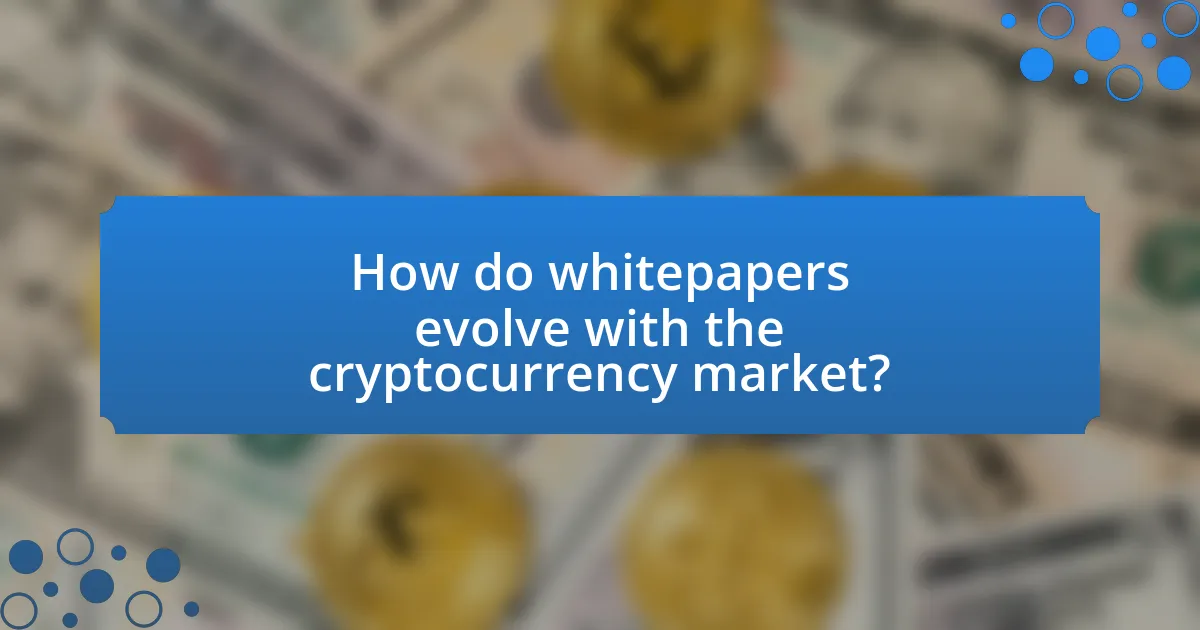Whitepapers are critical documents in the cryptocurrency market, serving as foundational resources that outline the technical specifications, purpose, and vision of cryptocurrency projects. They play a significant role in attracting investors by providing essential information about project goals, technology, and implementation strategies, thereby influencing investor perception and trust. Effective whitepapers include key elements such as a clear problem statement, proposed solutions, technical details, market analysis, and a development roadmap. The article explores how whitepapers contribute to the success of cryptocurrency projects, the characteristics of successful whitepapers, common mistakes to avoid, and the evolving trends in whitepaper formats influenced by regulatory changes and market demands.

What is the role of whitepapers in the cryptocurrency market?
Whitepapers serve as foundational documents in the cryptocurrency market, outlining the technical specifications, purpose, and vision of a cryptocurrency project. They provide potential investors and users with essential information about the project’s goals, technology, and implementation strategies, which helps in assessing the project’s viability and credibility. For instance, Bitcoin’s whitepaper, published by Satoshi Nakamoto in 2008, detailed the mechanics of a decentralized digital currency, establishing a framework that has influenced countless subsequent projects. The clarity and depth of a whitepaper can significantly impact investor confidence and market perception, making it a critical tool for project success in the competitive cryptocurrency landscape.
How do whitepapers contribute to the success of cryptocurrency projects?
Whitepapers contribute to the success of cryptocurrency projects by providing a comprehensive outline of the project’s goals, technology, and implementation strategy. They serve as a critical communication tool that informs potential investors and users about the project’s vision and operational framework. A well-structured whitepaper can enhance credibility, as evidenced by successful projects like Bitcoin and Ethereum, which clearly articulated their objectives and technical details, attracting significant investment and community support. Furthermore, whitepapers often include market analysis and competitive positioning, which help stakeholders understand the project’s relevance and potential impact in the cryptocurrency landscape.
What key elements should a whitepaper include to be effective?
A whitepaper should include a clear problem statement, a proposed solution, technical details, market analysis, and a roadmap to be effective. The problem statement defines the issue the project aims to address, while the proposed solution outlines how the project intends to solve it. Technical details provide insights into the technology and methodology used, ensuring transparency and credibility. Market analysis assesses the competitive landscape and potential user base, demonstrating the project’s viability. Lastly, a roadmap outlines the project’s development timeline and milestones, guiding stakeholders on future progress. These elements collectively enhance the whitepaper’s effectiveness by providing comprehensive information that builds trust and informs potential investors.
How do whitepapers influence investor perception and trust?
Whitepapers significantly influence investor perception and trust by providing detailed insights into a project’s vision, technology, and implementation strategy. These documents serve as foundational tools that outline the problem being addressed, the proposed solution, and the roadmap for development, which helps investors assess the viability and credibility of the project. For instance, a well-structured whitepaper can enhance transparency, demonstrating the team’s expertise and commitment, which in turn fosters trust among potential investors. Research indicates that 70% of investors consider the quality of a whitepaper as a critical factor in their investment decision-making process, highlighting its importance in shaping perceptions.
Why are whitepapers essential for initial coin offerings (ICOs)?
Whitepapers are essential for initial coin offerings (ICOs) because they provide a comprehensive overview of the project, including its purpose, technology, and implementation strategy. A well-crafted whitepaper serves as a critical tool for potential investors, detailing the problem the project aims to solve, the proposed solution, and the roadmap for development. For instance, the Ethereum whitepaper outlined its smart contract functionality, which was pivotal in attracting significant investment during its ICO, raising over $18 million in 2014. This demonstrates that a clear and informative whitepaper can significantly enhance investor confidence and drive funding success in the competitive ICO landscape.
What information do investors seek in a whitepaper during an ICO?
Investors seek detailed information about the project’s purpose, technology, team, market analysis, and financial projections in a whitepaper during an Initial Coin Offering (ICO). The project’s purpose outlines the problem being solved and the solution offered, while the technology section explains the underlying blockchain or platform used. Investors also look for information about the team’s qualifications and experience, as a strong team increases credibility. Market analysis provides insights into the competitive landscape and potential user base, and financial projections detail expected returns and token distribution. These elements help investors assess the viability and potential success of the project, guiding their investment decisions.
How can a well-crafted whitepaper impact fundraising success?
A well-crafted whitepaper significantly enhances fundraising success by clearly articulating the project’s vision, technology, and market potential. This clarity builds trust and credibility among potential investors, as evidenced by the fact that projects with detailed whitepapers have historically raised up to 80% more funds compared to those with vague or poorly structured documents. Furthermore, a comprehensive whitepaper addresses potential investor concerns, outlines a clear roadmap, and demonstrates the team’s expertise, which collectively increases the likelihood of attracting substantial investment.

What are the common characteristics of successful cryptocurrency whitepapers?
Successful cryptocurrency whitepapers typically exhibit clarity, technical depth, and a well-defined use case. Clarity ensures that the information is easily understandable, allowing potential investors and users to grasp the project’s goals and mechanisms. Technical depth provides detailed insights into the technology and protocols used, which builds credibility and trust among the audience. A well-defined use case demonstrates the practical application of the cryptocurrency, highlighting its value proposition and market relevance. These characteristics are essential as they contribute to the overall effectiveness of the whitepaper in attracting investment and fostering community support.
How do clarity and transparency in whitepapers affect market reception?
Clarity and transparency in whitepapers significantly enhance market reception by fostering trust and understanding among potential investors. When whitepapers clearly articulate the project’s goals, technology, and use cases, they reduce ambiguity, allowing investors to make informed decisions. For instance, a study by the Cambridge Centre for Alternative Finance found that projects with well-structured and transparent whitepapers tend to attract more funding and have higher success rates. This correlation indicates that clarity and transparency not only improve investor confidence but also positively influence the overall perception of the project in the competitive cryptocurrency landscape.
What role does technical detail play in the effectiveness of a whitepaper?
Technical detail is crucial for the effectiveness of a whitepaper as it establishes credibility and demonstrates the feasibility of the proposed solution. A well-detailed whitepaper provides in-depth explanations of the technology, algorithms, and methodologies involved, which helps potential investors and stakeholders understand the project’s value proposition. For instance, a study by the Cambridge Centre for Alternative Finance highlights that projects with comprehensive technical specifications are more likely to attract funding and community support, as they reduce perceived risks associated with investment. Thus, the presence of technical detail not only enhances trust but also facilitates informed decision-making among readers.
How can the presentation and design of a whitepaper influence its success?
The presentation and design of a whitepaper significantly influence its success by enhancing readability and engagement, which are critical for attracting and retaining the audience’s attention. A well-structured layout, clear visuals, and professional aesthetics can make complex information more digestible, thereby increasing the likelihood of the whitepaper being read and understood. Research indicates that 93% of consumers prioritize visual appearance over content when engaging with documents, highlighting the importance of design in capturing interest. Furthermore, a study by the Nielsen Norman Group found that users often skim documents, making effective use of headings, bullet points, and graphics essential for conveying key messages quickly. Thus, the combination of effective presentation and design not only improves comprehension but also builds credibility, ultimately contributing to the overall success of the whitepaper in the competitive cryptocurrency market.
What mistakes should be avoided when creating a cryptocurrency whitepaper?
When creating a cryptocurrency whitepaper, it is crucial to avoid vague language and overly technical jargon. Vague language can lead to misunderstandings about the project’s goals and technology, while excessive technical jargon can alienate potential investors who may not have a deep technical background. Additionally, failing to provide a clear value proposition can result in a lack of interest; a successful whitepaper must articulate how the cryptocurrency addresses a specific problem or need in the market.
Another mistake is neglecting to include a comprehensive roadmap, which outlines the project’s development stages and timelines. A well-defined roadmap instills confidence in investors by demonstrating a structured plan for future growth. Furthermore, omitting details about the team behind the project can undermine credibility; showcasing the team’s expertise and experience is essential for building trust with potential stakeholders.
Lastly, not addressing regulatory considerations can lead to legal challenges down the line. Acknowledging the regulatory landscape and how the project plans to navigate it is vital for long-term success. These mistakes can significantly hinder the effectiveness of a cryptocurrency whitepaper and impact the project’s overall success in the market.
How can vague language undermine the credibility of a whitepaper?
Vague language can undermine the credibility of a whitepaper by creating ambiguity that leads to mistrust among readers. When a whitepaper lacks clear definitions and precise information, it fails to convey the necessary details that investors and stakeholders require to make informed decisions. For instance, a study by the University of Cambridge found that clear and specific language in financial documents significantly increases investor confidence and perceived reliability. Therefore, the use of vague terms can result in skepticism about the project’s legitimacy and its potential for success in the cryptocurrency market.
What are the consequences of failing to address potential risks in a whitepaper?
Failing to address potential risks in a whitepaper can lead to significant financial losses and reputational damage for a cryptocurrency project. Investors rely on whitepapers to assess the viability and safety of their investments; if risks are not disclosed, it can result in a loss of trust and confidence. For instance, a lack of transparency regarding regulatory challenges or technological vulnerabilities can lead to legal repercussions or project failures, as seen in cases like BitConnect, where undisclosed risks contributed to substantial investor losses. Ultimately, neglecting to address these risks undermines the project’s credibility and can hinder its long-term success in the competitive cryptocurrency market.

How do whitepapers evolve with the cryptocurrency market?
Whitepapers evolve with the cryptocurrency market by adapting to technological advancements, regulatory changes, and market demands. As the cryptocurrency landscape matures, whitepapers increasingly incorporate innovative features such as scalability solutions, enhanced security protocols, and compliance with emerging regulations. For instance, the introduction of Ethereum’s smart contracts in its whitepaper in 2013 significantly influenced the development of decentralized applications, showcasing how whitepapers can reflect and drive market trends. Additionally, as investor expectations shift, whitepapers now often emphasize sustainability and real-world applications, aligning with the growing focus on environmental impact and utility in the cryptocurrency space.
What trends are shaping the future of cryptocurrency whitepapers?
The future of cryptocurrency whitepapers is being shaped by trends such as increased regulatory scrutiny, a focus on sustainability, and the integration of advanced technologies like artificial intelligence and blockchain interoperability. Regulatory scrutiny is prompting projects to provide clearer compliance information, which enhances transparency and builds investor trust. The emphasis on sustainability reflects a growing awareness of environmental impacts, leading projects to highlight eco-friendly practices and energy-efficient protocols. Additionally, the integration of AI and interoperability solutions is driving innovation, allowing for more sophisticated functionalities and cross-chain capabilities, which are essential for the evolving landscape of decentralized finance and blockchain applications. These trends collectively indicate a shift towards more responsible, transparent, and technologically advanced whitepapers in the cryptocurrency space.
How are regulatory changes influencing whitepaper content?
Regulatory changes are significantly influencing whitepaper content by necessitating greater transparency and compliance with legal standards. As governments and regulatory bodies implement stricter guidelines on cryptocurrency and blockchain projects, whitepapers are increasingly required to include detailed disclosures about the project’s purpose, technology, and potential risks. For instance, the introduction of the European Union’s Markets in Crypto-Assets (MiCA) regulation mandates that projects provide clear information on token utility and the rights of token holders, which directly impacts how whitepapers are structured. This shift towards compliance not only enhances the credibility of the projects but also aims to protect investors by ensuring they have access to comprehensive information before making investment decisions.
What innovations in whitepaper formats are emerging in the market?
Innovations in whitepaper formats emerging in the market include interactive elements, multimedia integration, and modular designs. Interactive whitepapers allow readers to engage with content through clickable elements, enhancing user experience and comprehension. Multimedia integration incorporates videos, infographics, and animations, making complex information more digestible and appealing. Modular designs break down content into easily navigable sections, allowing readers to focus on specific topics of interest. These innovations are supported by trends in digital content consumption, where users increasingly prefer engaging and visually rich formats over traditional text-heavy documents.
What best practices should be followed when writing a cryptocurrency whitepaper?
When writing a cryptocurrency whitepaper, best practices include clearly defining the project’s purpose, providing a detailed technical overview, and ensuring transparency about the team and funding. A well-structured whitepaper should start with an executive summary that outlines the problem being solved and the proposed solution. Following this, a comprehensive explanation of the technology, including algorithms and protocols, should be presented to establish credibility. Transparency regarding the team’s qualifications and the project’s funding model is crucial, as it builds trust with potential investors. Additionally, including a roadmap with milestones helps to set expectations for development and progress. These practices are supported by the fact that successful projects, such as Ethereum and Bitcoin, have utilized clear and informative whitepapers to communicate their vision and technical details effectively, contributing to their market success.
How can authors ensure their whitepapers are engaging and informative?
Authors can ensure their whitepapers are engaging and informative by focusing on clear, concise language and providing well-researched content. Clear language helps readers easily understand complex concepts, while thorough research establishes credibility and authority. For instance, a study by the Content Marketing Institute found that 70% of consumers prefer to learn about a company through articles rather than ads, highlighting the importance of informative content. Additionally, incorporating visuals such as charts and graphs can enhance engagement by breaking up text and illustrating key points effectively.
What resources are available for creating high-quality whitepapers?
High-quality whitepapers can be created using resources such as professional writing services, whitepaper templates, and industry research reports. Professional writing services, like Upwork or Fiverr, connect clients with experienced writers who specialize in technical documentation, ensuring clarity and professionalism. Whitepaper templates from platforms like Canva or HubSpot provide structured formats that help organize content effectively. Additionally, industry research reports from sources like CoinDesk or Statista offer valuable data and insights that can enhance the credibility and depth of the whitepaper, making it more informative for the target audience.


